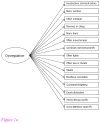Evaluation of the Strengths and Difficulties Questionnaire-Dysregulation Profile (SDQ-DP)
- PMID: 29927304
- PMCID: PMC6107405
- DOI: 10.1037/pas0000564
Evaluation of the Strengths and Difficulties Questionnaire-Dysregulation Profile (SDQ-DP)
Abstract
The Dysregulation Profile (DP) has emerged as a measure of concurrent affective, behavioral and cognitive dysregulation, associated with severe psychopathology, and poor adjustment. While originally developed with the Child Behavior Checklist, more recently the DP has also been defined on the Strengths and Difficulties Questionnaire (SDQ), mostly with a 5-item, but also a 15-item, SDQ-DP measure. This study evaluated the SDQ-DP by examining its factor structure, measurement invariance, and construct validity. Different SDQ-DP operationalizations were compared. In a United States longitudinal community sample (N = 768), a bifactor model consisting of a general Dysregulation factor and three specific factors of Emotional Symptoms, Conduct Problems, and Hyperactivity-Inattention fitted best, across three different developmental periods (early childhood, middle childhood, and adolescence) and across three different reporters (parents, teachers, and youth). Measurement invariance across reporter, gender, and developmental period was demonstrated. These findings indicate that the SDQ-DP, like the CBCL-DP, reflects a broad syndrome of dysregulation that exists in addition to specific syndromes of emotional symptoms, conduct problems, and hyperactivity-inattention. SDQ-DP bifactor scores were strongly related with scores on the 5- and 15-item SDQ-DP measures and similarly concurrently associated with two markers of self-regulation, ego-resiliency and effortful control, and longitudinally with antisocial behavior and disciplinary measures. As reliability, validity, and stability was weaker for the SDQ-DP 5-item measure, use of all 15 items is recommended. Advantages of using a bifactor approach are discussed as well as the potential of the SDQ-DP as an easy screening measure of children at risk for developing serious psychopathology. (PsycINFO Database Record
(c) 2018 APA, all rights reserved).
Figures



Similar articles
-
The Strengths and Difficulties Questionnaire Dysregulation Profile Teacher-Report: Psychometric Properties and Associations with Aspects of School Experience.Child Psychiatry Hum Dev. 2024 Jun;55(3):831-840. doi: 10.1007/s10578-022-01441-5. Epub 2022 Oct 13. Child Psychiatry Hum Dev. 2024. PMID: 36227387 Free PMC article.
-
The Dysregulation Profile in middle childhood and adolescence across reporters: factor structure, measurement invariance, and links with self-harm and suicidal ideation.Eur Child Adolesc Psychiatry. 2016 Apr;25(4):431-42. doi: 10.1007/s00787-015-0745-x. Epub 2015 Jul 31. Eur Child Adolesc Psychiatry. 2016. PMID: 26226917 Free PMC article.
-
Concurrence of the strengths and difficulties questionnaire and developmental behaviour checklist among children with an intellectual disability.J Intellect Disabil Res. 2018 Feb;62(2):150-155. doi: 10.1111/jir.12426. Epub 2017 Oct 5. J Intellect Disabil Res. 2018. PMID: 28980362
-
Review of the strengths and difficulties questionnaire translated into languages spoken by children and adolescents of refugee background.Int J Methods Psychiatr Res. 2017 Dec;26(4):e1568. doi: 10.1002/mpr.1568. Epub 2017 Apr 27. Int J Methods Psychiatr Res. 2017. PMID: 28449279 Free PMC article. Review.
-
Parents' Evaluation of Developmental Status and Strength and Difficulties Questionnaire as Screening Measures for Children in India: A Scoping Review.Pediatr Rep. 2023 Feb 24;15(1):175-196. doi: 10.3390/pediatric15010014. Pediatr Rep. 2023. PMID: 36976721 Free PMC article.
Cited by
-
The Strengths and Difficulties Questionnaire Dysregulation Profile Teacher-Report: Psychometric Properties and Associations with Aspects of School Experience.Child Psychiatry Hum Dev. 2024 Jun;55(3):831-840. doi: 10.1007/s10578-022-01441-5. Epub 2022 Oct 13. Child Psychiatry Hum Dev. 2024. PMID: 36227387 Free PMC article.
-
Cool and hot executive function problems in young children: linking self-regulation processes to emerging clinical symptoms.Eur Child Adolesc Psychiatry. 2024 Aug;33(8):2705-2718. doi: 10.1007/s00787-023-02344-z. Epub 2024 Jan 6. Eur Child Adolesc Psychiatry. 2024. PMID: 38183461 Free PMC article.
-
Characterizing subdomains of insistence on sameness in autistic youth.Autism Res. 2023 Dec;16(12):2326-2335. doi: 10.1002/aur.3033. Epub 2023 Sep 21. Autism Res. 2023. PMID: 37735979 Free PMC article.
-
Measurement Invariance in Longitudinal Bifactor Models: Review and Application Based on the p Factor.Assessment. 2024 Jun;31(4):774-793. doi: 10.1177/10731911231182687. Epub 2023 Jun 22. Assessment. 2024. PMID: 37350099 Free PMC article. Review.
-
Network relationships between emotional dysregulation and ADHD symptoms: an investigation of 13,207 clinical children and adolescents.Eur Child Adolesc Psychiatry. 2025 Jul 24. doi: 10.1007/s00787-025-02819-1. Online ahead of print. Eur Child Adolesc Psychiatry. 2025. PMID: 40705055
References
-
- Ayer L, Althoff R, Ivanova M, Rettew D, Waxler E, Sulman J, Hudziak J. Child Behavior Checklist Juvenile Bipolar Disorder (CBCL-JBD) and CBCL Posttraumatic Stress Problems (CBCL-PTSP) scales are measures of a single dysregulatory syndrome. Journal of Child Psychology and Psychiatry. 2009;50:1291–1300. doi: 10.1111/j.1469-7610.2009.02089.x. - DOI - PubMed
Publication types
MeSH terms
Grants and funding
LinkOut - more resources
Full Text Sources
Other Literature Sources
Medical
Research Materials

